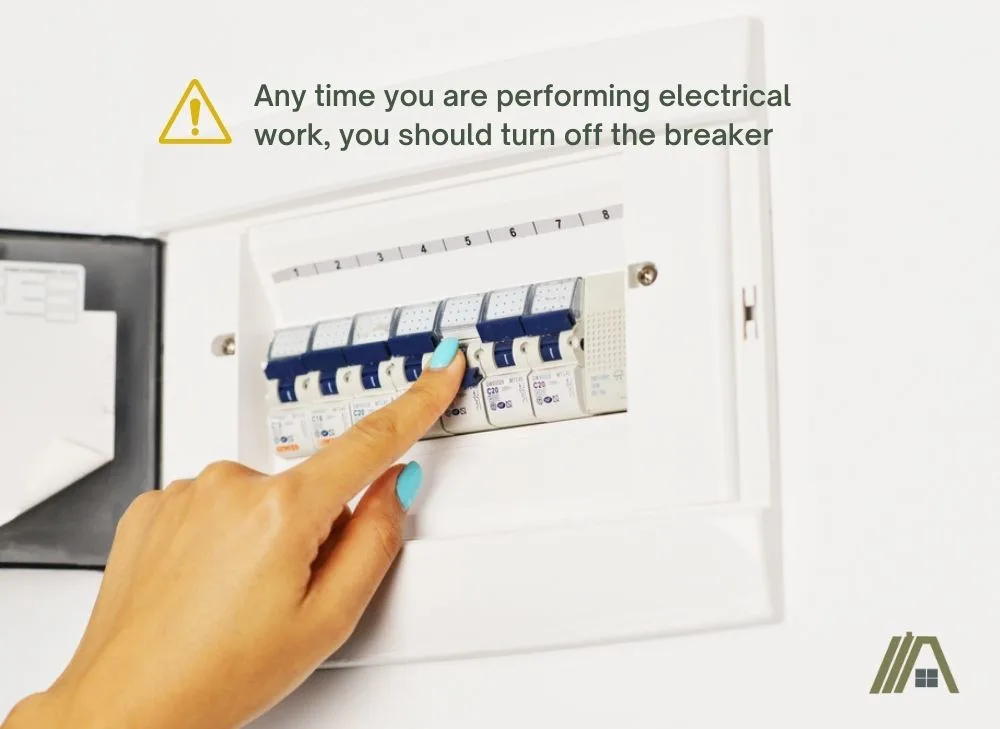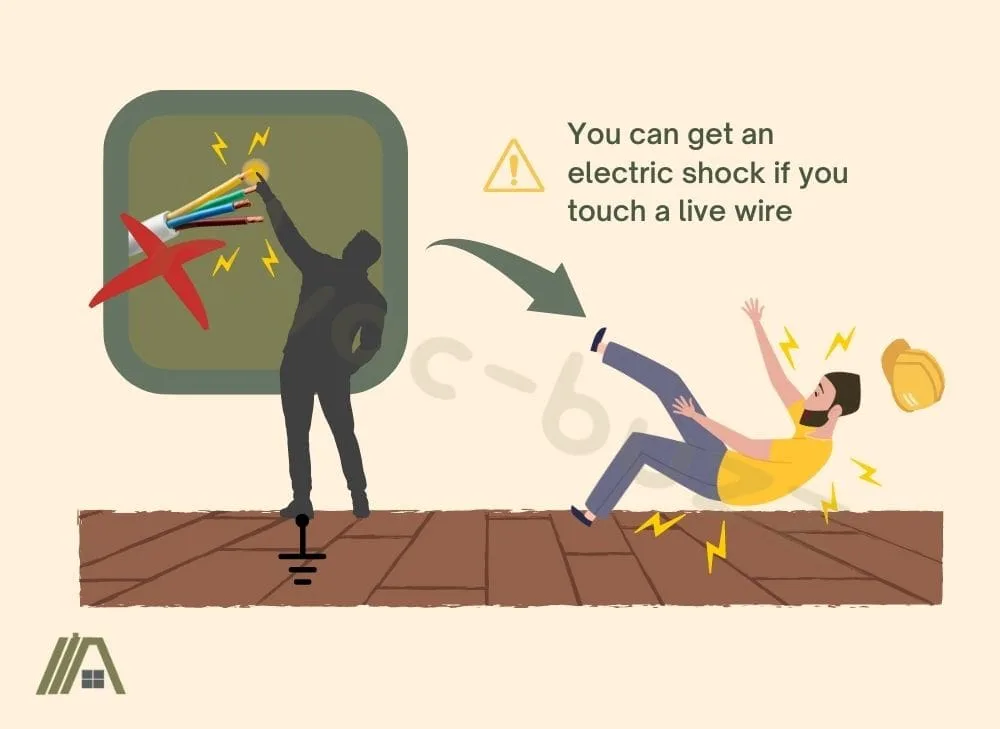Installing or swapping out a ceiling fan is probably one of the easier home DIYs out there as long as you can handle maneuvering all those fan blades! That said, sometimes there’s a way to cut corners and save time, even on the easy tasks.
Ceiling fans, or at this stage, the wires to which you are going to connect your ceiling fan, are often connected a wall switch. Turning off the breaker when there is no switch is obvious. But if there is a switch, could this be one of the time-saving tips for ceiling installation?

Never work with electrical cables when the power is still on at the breaker. Even if the ceiling fan is being connected to wires that feed through a wall switch, faulty wiring can mean the switch isn’t doing its job properly. Switches can also get flipped back on easily.
Always Turn off the Breaker
You can install a ceiling fan without turning off the breaker just like you can walk up to a lion and shake your hand in its face. Both are possible but you are unlikely to walk away unscathed (if at all).
Any time you are performing electrical work, you should turn off the breaker. No matter how simple the task, no matter if you are wearing protective gear, it is a very poor idea to work without cutting off the power to your workspace.

There is a reason every “how-to” post and video for ceiling fan installation (and every other type of electrical work) begins by telling you to cut the electricity off—it’s dangerous not to!
You could get severely injured or even die if you come into contact with a live wire.
I would even recommend turning the breaker off when you are cleaning the fan. No point in risking the electricity plus water combination.
But What if the Switch is Off?
Now that we’ve covered the obvious let’s get to the part that makes even some sensible people wonder if they need to turn the breaker off. I am speaking of ceiling fans linked to wall switches.
Some Wires May Still Be Live
There are two primary methods used for wiring a ceiling fan.
In the first method, you may technically be safe, as the wires run directly from the fan to the power switch. So, turning the switch off turns the power off to the cables that you would be working with.
In the second method, things get a bit more convoluted, but to put it in simple terms, the way that the wiring is installed means that there is always power to the ceiling junction box where the fan is mounted.
That means even when turning the switch off, there is power, and if you touch the wiring, you will get shocked.
Now, it’s not like you have x-ray vision to see which method was used to wire up your fan. Plus, even if you did, you wouldn’t be able to see if electricity is still somehow making its way to the fan with the switch off (yes, this can happen!).
In fact, because electrical work can be so dangerous and unexpected, you should use a voltmeter or voltage tester to double check that there aren’t ANY live wires even after you’ve flipped the switch and the breaker off.
- SAFETY FIRST: It will send out multiple alarms through sound and light. When the voltage is detected, the tip will send out red light and beep. When the higher the sensed voltage is, or the closer it...
- NON-CONTACT: With NCV inductive probe for AC voltage; Just place the tip near a terminal strip, outlet, or supply cord. When the tip glows red and the pen beeps, you know there's voltage present. The...
- DUAL RANGE: Detects standard and low voltage (12-1000V AC / 48-1000V AC) for more sensitive and flexible measurements. Press the S button to adjust sensitivity and adapt low range for doorbells,...
- SECURITY LEVEL: IEC rated CAT III 1000V CAT IV 600V, Meets CE requirements; The electrical tester is safely double insulated. High Voltage Alert to warn you of voltage above 90V, the screen turn red...
Last update on 2024-03-27 / Affiliate links / Images from Amazon Product Advertising API
Switches Are Easily Turned Back On
Let’s say your setup does happen to be perfect, and just turning the switch off guarantees there are no live wires and you’re safe to work on the fan.
Well…you’re actually still not safe.
If anyone walks into the room, they may flip the switch on out of habit. Maybe a family member comes in to check up on you or maybe you yourself leave the room, walk back in, flip the switch on absentmindedly and get back to work.
That might sound far-fetched, but it’s actually so easy to forget small details. How many times have you gotten lost in thought, or walked through a doorway and forgotten what you were doing?
Accidents can always happen and they do happen—more often than we care to think. It’s always better to work with caution and just turn the power off at the breaker box.
What Happens When You Touch a Live Wire?
If you touch a live wire while touching any kind of electrical ground, the current will pass through your body and deliver a shock. Similarly, if you are touching a live wire and another wire, you will receive a shock. In either scenario, your body completes a circuit.

Following these rules, it’s technically possible to touch a live wire and not get shocked if you are neither grounded in any way nor near another wire. However, it is extremely risky to rely on these rules alone to avoid shock.
You can easily be grounded without realizing it or touch another wire without meaning to since wires are often in close proximity to each other. Moreover, don’t forget that electricity can jump, meaning you don’t always need to be in direct contact with something to complete a circuit.
You risk so many potential negative effects from getting shocked from a brief moment of pain or unconsciousness to falling off your ladder or receiving electrical burns. You could face any number of injuries or even death.
These injuries aren’t exactly uncommon, either. There are about 30,000 injuries and 1,000 deaths to electrical shock each year in the United States alone.
Leave a Note By the Breaker
Electrical safety is so important that if you don’t live alone (or even if you do, but you’re the forgetful type), I would recommend leaving a note by the breaker that says not to turn the switch back on.
Again, you never know when someone may accidentally flip the switch while you’re working.
Every time you work with electricity, no matter how quick and easy the task may seem, you are putting yourself at risk. Always play it safe, in case you don’t live to be sorry!
Now, I do hope that I have convinced you to be sufficiently respectful of the wiring of a new ceiling fan installation. But because of this, I feel obliged to let you know that if you turn on your new fan and it emits a smell, it does not necessarily mean that there is an electrical issue. It can mean this, but more often, the smell is perfectly normal and will disappear.
Sources
https://www.elcosh.org/document/1624/887/d000543/section1.html
https://www.ncbi.nlm.nih.gov/books/NBK448087/
https://popularask.net/can-you-touch-a-live-wire-without-getting-shocked/
https://www.quora.com/Can-I-remove-a-ceiling-fan-without-turning-off-the-circuit-breaker

